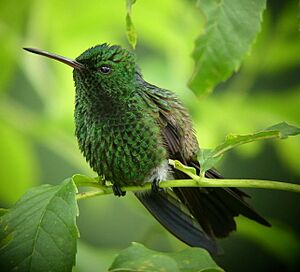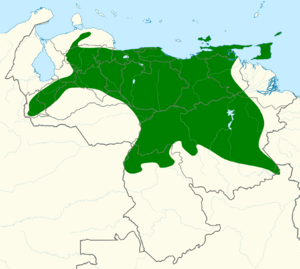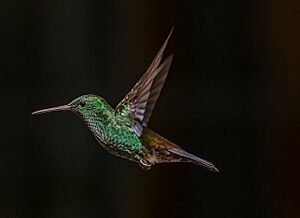Copper-rumped hummingbird facts for kids
Quick facts for kids Copper-rumped hummingbird |
|
|---|---|
 |
|
| S. t. erythronota, Trinidad | |
 |
|
| S. t. tobaci, Tobago | |
| Conservation status | |
| Scientific classification | |
| Genus: |
Saucerottia
|
| Species: |
tobaci
|
 |
|
| Range in green | |
| Synonyms | |
|
Amazilia tobaci |
|
The copper-rumped hummingbird (Saucerottia tobaci) is a beautiful type of hummingbird. It belongs to a group of hummingbirds called "emeralds." You can find this bird in places like Tobago, Trinidad, and Venezuela. It might also live in Grenada.
Contents
About the Copper-Rumped Hummingbird's Name
The copper-rumped hummingbird was first officially described in 1788. A German scientist named Johann Friedrich Gmelin gave it its first scientific name, Trochilus tobaci. He based his description on notes from another scientist, John Latham, who had seen the "Tobago Humming-Bird."
For a long time, this hummingbird was placed in a group called Amazilia. However, after scientists studied their DNA in 2014, they found that the Amazilia group was not quite right. So, most scientists moved the copper-rumped hummingbird to a different group, or genus, called Saucerottia. This new group name was created in 1850 by a French scientist named Charles Lucien Bonaparte. The name Saucerottia honors a French doctor and bird expert, Antoine Constant Saucerotte. The "tobaci" part of its name comes from the island of Tobago, where it was first found.
There are seven different types, or subspecies, of the copper-rumped hummingbird. Each subspecies has slight differences in where they live and how they look.
What Does a Copper-Rumped Hummingbird Look Like?
The copper-rumped hummingbird is a small bird. It is about 9 to 11 centimeters (3.5 to 4.3 inches) long. Males weigh about 4.6 to 4.7 grams (0.16 ounces), and females are a bit lighter, weighing 3.5 to 4.2 grams (0.12 to 0.15 ounces). The biggest type is S. t. tobaci.
Both male and female copper-rumped hummingbirds have a straight, blackish beak. The bottom part of their beak is usually pinkish.
- Males of the S. t. tobaci type have shiny bronze-green feathers on their upper body. Their feathers near the tail are a pretty purple-red. Their chest and belly are dark golden-green, and the feathers under their tail are reddish-brown. Their tail is a purplish-black color.
- Females look similar to males. However, their bronze-green upper parts are not as bright. They also have some whitish feathers on their chin and upper throat.
- Young birds look like females. They might have some grayish-brown feathers on their throat and belly.
Other types of copper-rumped hummingbirds have small differences. For example, some have a steel blue tail, while others have a blue-black tail. Some might have more copper colors on their upper body.

Where Do Copper-Rumped Hummingbirds Live?
Copper-rumped hummingbirds live in different areas depending on their subspecies:
- S. t. monticola lives in northwestern Venezuela.
- S. t. feliciae is found in north and central Venezuela.
- S. t. caudata lives in northeastern Venezuela.
- S. t. aliciae is found on Margarita Island off the coast of Venezuela.
- S. t. erythronotos lives on Trinidad.
- S. t. tobaci lives on Tobago.
- S. t. caurensis is found in southeastern Venezuela.
It was once thought that these birds lived in Grenada. However, scientists now believe those birds were actually from Tobago. So, it's not likely they live in the Lesser Antilles islands.
These hummingbirds can live in many different kinds of forests. This includes cloudforests, rainforests, and forests that are growing back. The types found on Trinidad and Tobago also live in open grasslands, farms, and gardens. Most copper-rumped hummingbirds live from sea level up to about 1,000 meters (3,300 feet) high. However, some types can live even higher, up to 2,000 meters (6,600 feet).
How Do Copper-Rumped Hummingbirds Behave?
Movement and Travel
The copper-rumped hummingbirds that live on islands usually stay in one place. They do not travel far. The ones that live on the mainland might move around locally, but they don't migrate long distances.
What Do They Eat?
The copper-rumped hummingbird mainly eats nectar from flowers. They get nectar from at least 40 different types of plants, including trees, vines, and garden flowers. They are very protective of their feeding spots. They will chase away other birds, even bigger ones, to defend their food. Besides nectar, they also eat small insects. They catch insects by flying out from a perch or by picking them off plants.
How Do They Raise Their Young?
On Trinidad, copper-rumped hummingbirds can breed almost all year. Their busiest breeding time is from January to March. On Tobago, they breed from November to June. Scientists don't know much about the breeding times for the hummingbirds on the mainland.
The female hummingbird builds a small, cup-shaped nest. She uses soft plant fibers and decorates the outside with lichen. She usually places the nest in a tree fork or on a small branch. The nest is often about 1 to 3 meters (3 to 10 feet) above the ground. Sometimes, they build nests as high as 6 meters (20 feet). They have even been found building nests on wires or clotheslines!
The female lays two eggs. She sits on the eggs for 16 to 19 days to keep them warm. After the chicks hatch, they stay in the nest for another 19 to 23 days until they are ready to fly. A female hummingbird can raise up to three groups of chicks in one breeding season.
What Do They Sound Like?
The song of the copper-rumped hummingbird is a repeated sound. It has three buzzy or squeaky notes that are spaced out, like "tee-dee-dew" or "tee-dzee-djit." When they are looking for food, they also make high-pitched rattling sounds.
Are Copper-Rumped Hummingbirds in Danger?
The IUCN (International Union for Conservation of Nature) says the copper-rumped hummingbird is a species of "Least Concern." This means they are not currently in danger of disappearing. Scientists don't know exactly how many of these birds there are or if their numbers are changing. However, they live in a large area, and there are no big threats to them right now.
The hummingbirds on Trinidad and Tobago, and some mainland types, are quite common. Other types might be harder to find, but this could be because scientists haven't studied them as much.


